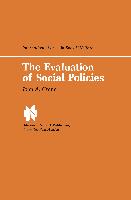- Start
- The Evaluation of Social Policies
The Evaluation of Social Policies
Angebote / Angebote:
Policy Evaluation and Evaluation Policy.- Evaluation as a Discipline.- Purposes of This Study.- Treatment of Methods.- Plan.- Level of Difficulty of Presentation.- I Valuation.- 1 Issues in Evaluation Policy.- An Overview of Evaluation Approaches.- A Schema for Comparing Approaches.- 2 Evaluation and Social Research.- Evaluation as Scientific Theory Testing.- Limitations of the Scientific Theory-Testing Approach.- Evaluation as Applied Scientific Methods.- The Applied Scientific Methods Approach: A Critique.- The Problem of Naturalism in Evaluation.- Evaluation as Directed Social Change.- Limitations of Evaluation as Directed Social Change.- 3 Evaluation and Social Justice.- A Utilitarian Perspective on Policy Evaluation.- An Egalitarian Perspective.- The Egalitarian Perspective on Nuclear Power.- Inequality in the Social Services.- The Egalitarian Approach: A Critique.- 4 A Framework for Valuation.- Evaluation as a Form of Social Inquiry.- Context and Scope of Valuation.- Relating Valuations to Observations.- Comprehensive Evaluation.- Appropriate Policies to Guide Uncertain Inferences.- Roles of Scientist and Citizen in Valuation.- II Valuation and Observation.- 5 Technique of Value Scaling.- The Outcome Measure and the Value Scale.- Magnitude Estimation.- Method of Obtaining Magnitude Estimates: Exhibit 1.- Finding Relative Origins: Exhibit 2.- Meaning of the Relative Origin.- Understanding Power Functions of Outcome Scores.- Bipolar Value Scales.- Multiple Measures of Effect for Each Value Scale.- Units of the Value Scale.- Magnitude Estimation and Social Dissension.- Magnitude Estimation as a Tool of Social Evaluation.- 6 Relationships That Determine Outcomes of Tests of Hypotheses.- The Outcome Probability.- Formulating the Null and Threshold Hypotheses.- The Discrepancy Measure (D) as a Proxy for the Outcome Probability.- Direct Determinants of the Outcome Probability.- Unreliability, Invalidity, and Sample Variances.- Effects of Inconsistent Intervention Effects.- Effects of Protection against Type 1 and Type 2 Errors on Sample Size Requirements.- Recapitulation.- 7 Squaring Research Design with Policy Requirements.- Specification of Values: An Example.- Measurement Design.- Outcome Measure.- Magnitude Estimation of Effectiveness.- Patterning of Observations.- Formulating the Threshold Hypothesis.- Determining an Optimum Level of Protection against Type 1 and Type 2 Errors.- Variations in the Research Design by Types of Evaluation Questions.- Recapitulation 107.- The Problem of Generalizing from Policy Evaluation.- III Observation and Inference.- 8 Plausible and Implausible Hypotheses.- Specification of Hypotheses.- The Measurement of Plausibility.- Likelihood Inference.- Maximum Likelihood.- Likelihood Functions.- Relative Likelihood.- Joint Relative Likelihood Analysis: An Example.- 9 Fluctuating Parameters.- Local Probabilistic Systems.- Diachronic Sampling.- Bayesian Inference.- Sources of the Prior Distribution.- Forms and Uses of Posterior Distribution.- Bayesian Decision Rules.- 10 A Classification of Evaluative Inference Methods.- Overview of the Classification.- No Prior Data, Dichotomous Value Scale: Case 1.- Prior Information, Dichotomous Value Scale: Case 2.- No Prior Data, Ratio Value Scale: Case 3.- Prior Information, Ratio Value Scale: Case 4.- IV Two Case Studies in Evaluation.- 11 Technical Skew in Social Work Evaluations.- Essentials of TECH.- The Prevalence of TECH.- Two Examples of TECH in Social Work Research 151.- Planned and Unplanned Features of TECH-Mode Designs.- Implicit Threshold Hypotheses.- Taking Account of Type 1 and Type 2 Errors.- 12 A Reanalysis of Love Canal Data on Spontaneous Abortions.- The Scientific Controversies 161.- The Question of Controls in the Studies of Birth Abnormalities.- Plan of Reanalysis of the Data on Miscarriages.- Relative Likelihood Analysis.- Implications.- Appendix: Evaluating Likelihoods Using an Electronic Calculator or the Computer.- Calculating Joint Relative Likelihoods for Binomial Populations Using an Electronic Calculator.- Program: Binomial Likelihoods.- Program: ¿Example Run¿ 181.- Extension to the Multinomial Case: Calculation of Multinomial Likelihoods Using a Desk or Hand Calculator.- Program S.Multi.- Calculating Relative Likelihoods for a Poisson Mean Using an Electronic Calculator.- Program Poisson.- Program Poisson: A Sample Run.- Calculation of the Maximum Relative Likelihood for the Mean of a Normal Sample Using an Electronic Calculator.- Program Normal Likelihoods.- Notes.- References.- Name Index.
Folgt in ca. 5 Arbeitstagen
